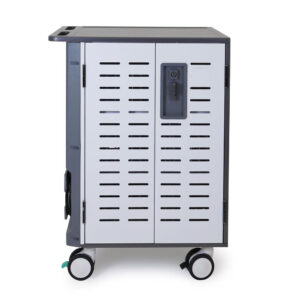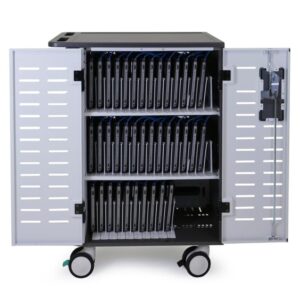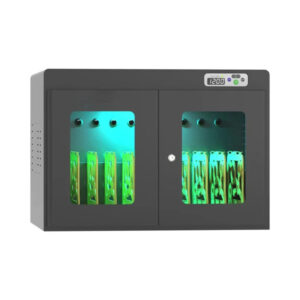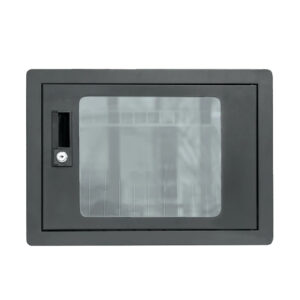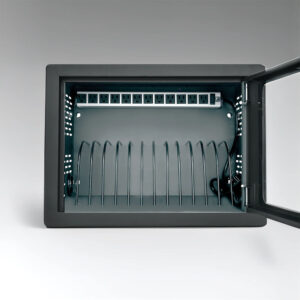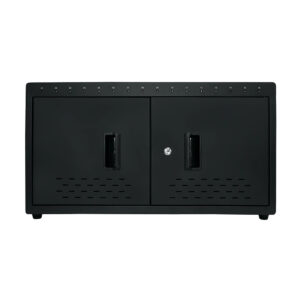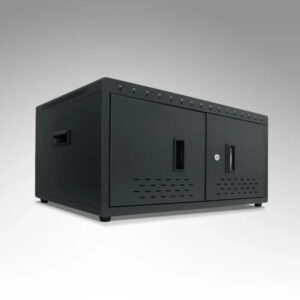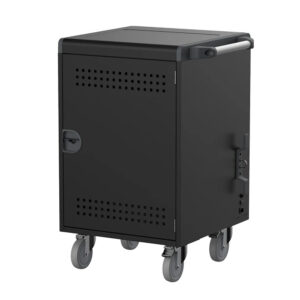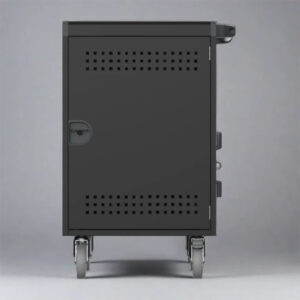Summary
Charging solutions for electronic devices, such as laptops, tablets, and smartphones, have become essential in educational and professional settings, leading to the development of various types of equipment designed to facilitate efficient and secure charging. Among these solutions, charging carts, cabinets, lockers, and stations each serve unique purposes and cater to different user needs, highlighting the importance of understanding their distinct functionalities and applications in managing technology effectively.
Charging carts are mobile units that allow for the simultaneous charging of multiple devices while providing the flexibility to transport them across different locations, making them ideal for dynamic environments such as classrooms and meeting spaces. Conversely, charging cabinets are stationary storage units designed to securely charge devices in a single location. They often include advanced features such as surge protection and smart charging technology, focusing on security and efficient management of devices in settings like schools and corporate offices. Charging lockers, equipped with individual compartments and locking mechanisms, enhance security and organization, ensuring devices are safely stored and easily accessible, especially in high-traffic areas.
The notable differences between these charging solutions primarily revolve around mobility, security, and user accessibility. Charging carts excel in scenarios that require easy movement and quick deployment, while charging cabinets provide a secure, centralized location for device storage and charging. Charging lockers offer customizable security options, making them suitable for environments where theft prevention is critical. Understanding these distinctions helps organizations select the appropriate solution based on their specific needs and usage patterns.
As technology continues to evolve, the integration of charging stations—which combine features of carts, cabinets, and lockers—provides a comprehensive approach to device management, further enhancing efficiency and organization across various settings. The ongoing advancements in charging technologies and user requirements will likely continue to shape the development of these solutions, addressing contemporary challenges in device management and security.
Table of Contents
Charging Carts
Charging carts are mobile storage solutions designed to facilitate the simultaneous charging of multiple devices, such as laptops, tablets, and Chromebooks. They typically feature multiple shelves or compartments where devices can be securely placed and charged at the same time. The mobility of these carts is one of their key benefits, as they are equipped with sturdy, lockable wheels, allowing for easy transportation between classrooms, offices, or meeting rooms.
Charging Cabinets
Charging cabinets, also referred to as charging stations or charging carts, are specialized secure storage units designed to charge multiple electronic devices concurrently. Equipped with built-in power outlets, USB ports, and sometimes advanced features such as surge protection, cooling fans, and smart charging technology, these cabinets cater specifically to educational institutions and environments where various devices like tablets, laptops, Chromebooks, and smartphones are regularly utilized.
Charging Lockers
Charging lockers are specialized storage solutions designed to securely house and charge electronic devices, such as tablets and laptops, within educational and professional environments. They are particularly beneficial in schools and offices where device management and security are paramount.

Key Features
Security
One of the primary advantages of charging lockers is their enhanced security. Each locker is equipped with a locking mechanism, which can range from traditional keys to advanced digital locks that utilize personal identification numbers (PINs) or biometric authentication. This ensures that devices are protected from theft and unauthorized access, making them suitable for high-traffic areas where devices might be left unattended.
Organization
Charging lockers contribute to a clean and organized environment by providing designated storage for each device. With individual compartments featuring built-in power outlets and USB ports, they eliminate the need for tangled wires and facilitate easy charging without searching for available outlets. This dedicated space helps reduce clutter, allowing students and staff to quickly locate and store their gadgets.
Customization
Another notable aspect of charging lockers is their customizable configurations. Administrators can select from various sizes, designs, and functionalities to suit specific requirements, making them versatile enough for different environments, from classrooms to corporate offices. This adaptability also extends to accommodating future advancements in charging technologies.
Integration and Scalability
Charging lockers can be seamlessly integrated with existing security systems within an institution, enhancing overall safety and device management. Moreover, they are designed to be scalable; additional locker modules can be added as the needs of the institution grow, allowing for targeted investments in technology infrastructure.

Charging Stations
Charging stations are specialized devices designed to efficiently charge multiple electronic devices simultaneously while providing secure storage solutions. These stations have gained significant traction in various environments, including educational institutions, workplaces, and healthcare facilities, where the need to keep devices charged and organized is paramount.
Overview of Charging Stations
A charging station typically consists of a cabinet or unit equipped with multiple charging slots, allowing it to accommodate a variety of devices, such as laptops, tablets, and smartphones. Many of the best charging stations are constructed from durable materials like steel and feature lockable doors to enhance security and protect the devices inside.
Types of Charging Stations
There are several types of charging stations, each catering to specific needs:
Charging Carts: Mobile units that are often equipped with multiple shelves or compartments, charging carts facilitate the simultaneous charging of numerous devices while allowing for easy transport. These are particularly useful in settings where devices are frequently moved between locations, such as classrooms or meeting rooms.
Charging Cabinets: Unlike carts, charging cabinets provide a stationary and secure option for device storage. They are designed for environments that prioritize security, such as schools and corporate offices. Charging cabinets often include features such as intelligent charging technology to prevent under or overcharging, ensuring devices are maintained in optimal condition.
Smart Lockers: These systems offer an innovative approach to charging and device management by enabling individual checkouts and secure storage. Smart lockers allow users to access specific devices easily while providing automated oversight to track which devices are checked out and returned.
Benefits of Using Charging Stations
The installation of charging stations can offer multiple advantages:
Efficiency: Charging stations eliminate the chaos associated with locating multiple charging outlets. With designated slots for each device, users can quickly retrieve the devices they need without searching for working chargers.
Organization: By providing a centralized hub for charging, these stations help keep devices organized and ready for use, which is particularly beneficial in educational settings where time is of the essence.
Security: Lockable charging cabinets and carts provide an extra layer of security, protecting valuable devices from theft and damage while they charge.
Adaptability: Many charging stations are designed to handle various device types and sizes, making them versatile solutions for different environments.

Comparative Analysis
Overview of Charging Solutions
In modern environments, particularly in educational and professional settings, the need for effective charging solutions is paramount. Among the most common solutions are charging carts, cabinets, lockers, and stations, each designed to cater to specific needs based on functionality, security, and mobility considerations.
Charging Carts vs. Charging Cabinets
Charging Carts
Charging carts are mobile units that allow for flexible deployment of IT devices. They are ideal for scenarios where devices need to be transported between locations or used in different settings. One of their key advantages is mobility, which facilitates easy access to devices as well as quick setup in various environments. Furthermore, charging carts typically require AC adapters and can incorporate additional features like USB ports for enhanced usability.
Charging Cabinets
In contrast, charging cabinets are stationary and designed to provide a secure charging environment for IT devices. They are often used in settings where devices will remain in a single location, offering enhanced security features to prevent theft or damage. Charging cabinets require less frequent interaction, as they can be left plugged in continuously, making them suitable for environments with limited power outlets. However, they may lack the mobility that charging carts provide, making them less ideal for dynamic settings.
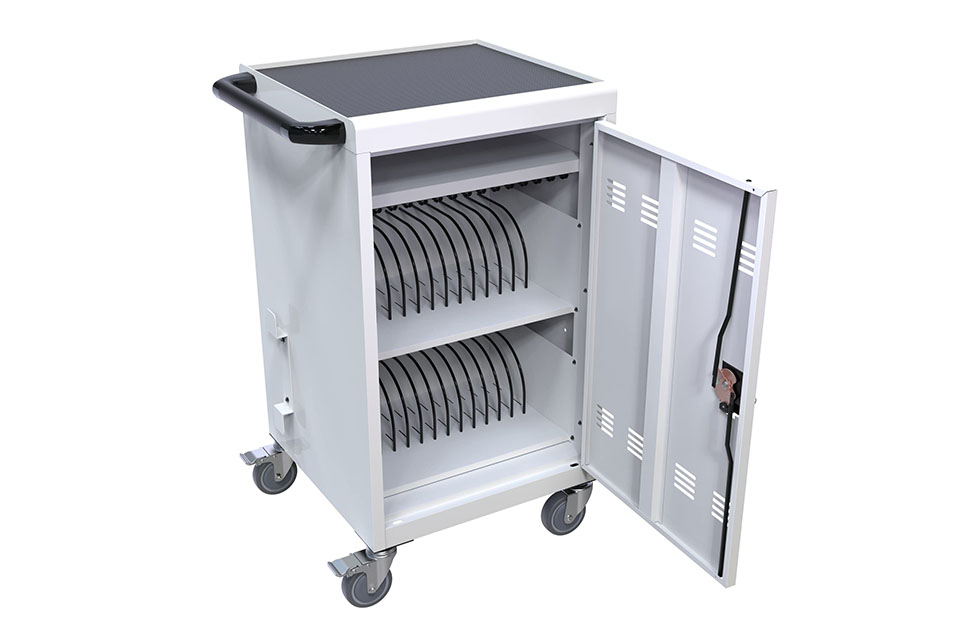
User Considerations and Configurations
Usage Patterns
Understanding user behavior is crucial when selecting between charging carts and cabinets. Research indicates that configurations can significantly influence user preferences regarding charging habits and device accessibility. For instance, charging cabinets may be preferable in situations where devices are checked out one by one, while carts might be more suitable for group activities where devices need to be shared quickly.
Security vs. Accessibility
Security is another critical factor. Charging cabinets often incorporate robust security features, making them ideal for protecting valuable technology. Conversely, charging carts offer quicker access to devices, which can be advantageous in fast-paced environments where time is of the essence. Organizations must carefully assess their specific needs to determine the most suitable option based on these dynamics.



